Case of a 9 Year Old with Intense Leg Pain and a Lost Summer Fixed by Muscle Energy (MET) 2/21/19
 I really enjoy treating kids, especially elementary aged and teenagers because they tend to respond so well to osteopathic manipulation. Recently I wrote about a 5-year-old with left leg pain that was keeping her awake at night and really limiting her with playing and being active. She had somatic dysfunction present that was changing how her pelvic girdle was functioning and was creating her pain. A couple visits and she is back to normal. I had another experience with a young lady recently, aged 9 that was very similar. She is a dancer, active, very talkative and an all-around enjoyable great kid! Her mom got ahold of me based on a recommendation from another teens mom that I helped back into sports. This young lady’s mother called me back in September and seemed very exasperated due to the fact she had a child with leg and hip pain that was really affecting her being a kid. It all started back in mid-May when her left leg began to give way with walking for some unknown reason. It kept getting worse and by the end of May she was unable to sit in the criss cross position on the floor due to pain and lack of motion in her left hip. At the beginning of June, she went to Nationwide Children’s and saw an orthopedic physician. X-rays were performed that came back normal and she got the diagnosis of bursitis and was prescribed anti-inflammatories. I see this all too often. One of the problems is a horrible exam is performed or not really performed at all. If a good clinical exam was performed, it would be known the pain was not coming from hip bursitis…very frustrating! Of course, the anti-inflammatories did not work, and her symptoms became worse and at this point she was having a hard time walking, was crying in pain and could not rotate her hip into external rotation, which is the position where the toes turn out. She had an MRI done in mid-June that also came back as normal so the ortho doctor performed a hip joint injection for pain control and diagnostic purposes. She did not get any relief from the injection and at the end of June she started traditional physical therapy. It was thought maybe she had a labral tear, but this was ruled out at this point in time. Her pain kept getting worse and the ortho department at Children’s Hospital sent her to the Sports Medicine Department in July. She was prescribed gabapentin, which is a powerful nerve pain reducer and anticonvulsant medication, along with another round of anti-inflammatory medicine. Her pain did not change, and she was using crutches at this time and due to the lack of progress Children’s Sports Medicine department sent her to Cleveland Clinic’s rheumatology department to make sure she did not have an autoimmune disorder. After that trip, the young girl and her family were left deflated and feeling hopeless because Cleveland Clinic was unable to help. Time continued to pass, and nothing really changed, and it was mid-August when another hip injection was tried without help. Around this same time, the exhausted little girl was sent to Children’s Cincinnati for a second opinion and to further rule out a labral tear. She underwent another injection under sedation with a specialized MRI that can better visualize the hip labrum. That test also came back normal. Throughout all this time, her whole summer was lost, she missed out on dance, which she loves, and the beginning of school was being affected. The whole family was feeling hopeless I was told. It was the end of September when I received a phone call from the young girl’s mother. It was explained to me what was going on and what the symptoms were and a general history of all the treatments that were tried. From the phone conversation I remember saying I am pretty sure I can help in a couple of visits. It sounded like the typical history of a lumbosacral dysfunction that was shutting down the glutes and causing pain to go into the hip and into the leg. These dysfunctions are not easily diagnosed unless a good clinical exam is performed, and one knows what to look for. These are the kinds of patients I fix all the time and the history tends to be similar so that is why I was confident I could help this young lady. The first treatment was in the beginning of October and I knew what was going on from the evaluation I performed. She had left hip and leg pain, had a moderate limp with gait, had very little hip external rotation present, very weak glute max and medius muscles, and core weakness. Her left hamstring was increased in tone/tightness due to her glutes being shut down and inhibited, which happens quite often. The hamstrings will tighten to help create stability of the pelvic girdle when the glutes are not doing their job. I treat using Muscle Energy Technique, which is an Osteopathic Manipulation, along with myofascial release, stretching, and exercises that complement the manual medicine. After the first visit she did not feel significantly better, but when I assessed her on her second visit, I knew I would win the battle. Her spine moved better, her glutes were firing easier, and her hamstrings were not as toned/tight. She still had some of the same dysfunction present due to the fact her spine had not been properly mechanically working for months. By the third visit she was significantly better. She looked pretty much back to normal. I did see her for a fourth visit just to make sure we had it beat. She was able to return to dance and get back to be the normal, rambunctious little girl she had been before May when this all started. This is why I am so passionate about manual medicine and the manual medicine program at Michigan States Osteopathic Medical School. These professors and teachers have changed my way of thinking bout the body, how to assess and treat pain. The more I learn, the more I realize I am only scratching the surface of healing from manual medicine. The bad part is people don’t know manual medicine exists and they are so used to just taking medicine, doing traditional therapy, or listening to the physician that says nothing is wrong. Well there are other treatments that are very successful and powerful out there, but the hard part is getting people with pain to learn about them. I’m trying one patient and word of mouth at a time!
I really enjoy treating kids, especially elementary aged and teenagers because they tend to respond so well to osteopathic manipulation. Recently I wrote about a 5-year-old with left leg pain that was keeping her awake at night and really limiting her with playing and being active. She had somatic dysfunction present that was changing how her pelvic girdle was functioning and was creating her pain. A couple visits and she is back to normal. I had another experience with a young lady recently, aged 9 that was very similar. She is a dancer, active, very talkative and an all-around enjoyable great kid! Her mom got ahold of me based on a recommendation from another teens mom that I helped back into sports. This young lady’s mother called me back in September and seemed very exasperated due to the fact she had a child with leg and hip pain that was really affecting her being a kid. It all started back in mid-May when her left leg began to give way with walking for some unknown reason. It kept getting worse and by the end of May she was unable to sit in the criss cross position on the floor due to pain and lack of motion in her left hip. At the beginning of June, she went to Nationwide Children’s and saw an orthopedic physician. X-rays were performed that came back normal and she got the diagnosis of bursitis and was prescribed anti-inflammatories. I see this all too often. One of the problems is a horrible exam is performed or not really performed at all. If a good clinical exam was performed, it would be known the pain was not coming from hip bursitis…very frustrating! Of course, the anti-inflammatories did not work, and her symptoms became worse and at this point she was having a hard time walking, was crying in pain and could not rotate her hip into external rotation, which is the position where the toes turn out. She had an MRI done in mid-June that also came back as normal so the ortho doctor performed a hip joint injection for pain control and diagnostic purposes. She did not get any relief from the injection and at the end of June she started traditional physical therapy. It was thought maybe she had a labral tear, but this was ruled out at this point in time. Her pain kept getting worse and the ortho department at Children’s Hospital sent her to the Sports Medicine Department in July. She was prescribed gabapentin, which is a powerful nerve pain reducer and anticonvulsant medication, along with another round of anti-inflammatory medicine. Her pain did not change, and she was using crutches at this time and due to the lack of progress Children’s Sports Medicine department sent her to Cleveland Clinic’s rheumatology department to make sure she did not have an autoimmune disorder. After that trip, the young girl and her family were left deflated and feeling hopeless because Cleveland Clinic was unable to help. Time continued to pass, and nothing really changed, and it was mid-August when another hip injection was tried without help. Around this same time, the exhausted little girl was sent to Children’s Cincinnati for a second opinion and to further rule out a labral tear. She underwent another injection under sedation with a specialized MRI that can better visualize the hip labrum. That test also came back normal. Throughout all this time, her whole summer was lost, she missed out on dance, which she loves, and the beginning of school was being affected. The whole family was feeling hopeless I was told. It was the end of September when I received a phone call from the young girl’s mother. It was explained to me what was going on and what the symptoms were and a general history of all the treatments that were tried. From the phone conversation I remember saying I am pretty sure I can help in a couple of visits. It sounded like the typical history of a lumbosacral dysfunction that was shutting down the glutes and causing pain to go into the hip and into the leg. These dysfunctions are not easily diagnosed unless a good clinical exam is performed, and one knows what to look for. These are the kinds of patients I fix all the time and the history tends to be similar so that is why I was confident I could help this young lady. The first treatment was in the beginning of October and I knew what was going on from the evaluation I performed. She had left hip and leg pain, had a moderate limp with gait, had very little hip external rotation present, very weak glute max and medius muscles, and core weakness. Her left hamstring was increased in tone/tightness due to her glutes being shut down and inhibited, which happens quite often. The hamstrings will tighten to help create stability of the pelvic girdle when the glutes are not doing their job. I treat using Muscle Energy Technique, which is an Osteopathic Manipulation, along with myofascial release, stretching, and exercises that complement the manual medicine. After the first visit she did not feel significantly better, but when I assessed her on her second visit, I knew I would win the battle. Her spine moved better, her glutes were firing easier, and her hamstrings were not as toned/tight. She still had some of the same dysfunction present due to the fact her spine had not been properly mechanically working for months. By the third visit she was significantly better. She looked pretty much back to normal. I did see her for a fourth visit just to make sure we had it beat. She was able to return to dance and get back to be the normal, rambunctious little girl she had been before May when this all started. This is why I am so passionate about manual medicine and the manual medicine program at Michigan States Osteopathic Medical School. These professors and teachers have changed my way of thinking bout the body, how to assess and treat pain. The more I learn, the more I realize I am only scratching the surface of healing from manual medicine. The bad part is people don’t know manual medicine exists and they are so used to just taking medicine, doing traditional therapy, or listening to the physician that says nothing is wrong. Well there are other treatments that are very successful and powerful out there, but the hard part is getting people with pain to learn about them. I’m trying one patient and word of mouth at a time!
Manual Therapy Can Help People of all Ages; most recently a 5 year old! 2/2/19

I had an interesting experience recently. I received a call from a mother with a little girl, age 5, with pain in her left leg. It really bothered her at night and was waking her. Nothing really seemed to help. From my memory, chiropractic care and massage were tried without much lasting help and the family was looking for another option that might help their little girl that was on the natural side. They did not want to deal with medication or injection and diagnostically nothing seemed to be wrong. They showed up at my office and the little girl was cute as a button. She was wild and rambunctious like I was expecting but at the same time she had this left leg complaint that sounded very familiar. No known injury or causative factor, but the leg hurt, and it would not go away. I hear those complaints a lot, but not typically from a 5-year old. I did what I normally would do and performed a mechanical evaluation of her lumbar spine and pelvis. I was surprised to find the same abnormal mechanics I usually find in the teens and adults I treat. She had a sacral torsion and a dysfunction at her L5 vertebra that was creating her leg pain. I treated what I found, and her spine and pelvis corrected very easily. After 2 visits I never saw her again. The last I checked in with the family, the little girl had not complained about it in weeks! I was actually sort of shocked at this case because I had never had a client so young, but what I found was exactly what I would expect to find based on her pain complaints. This goes to show performing manual medicine can help people of all ages and to treat what is found and not limit clients based on age. That is exactly what I did, and it took only 2 visits to get rid of the pain. Manual therapy using muscle energy technique (MET) is amazing.
My Cash Based Physical Therapy Practice Because Non-Insurance Allows Better Treatment 8/19/17
Low Back Pain and Pelvic Girdle Dysfunction 8/6/17
 Have you ever had low back pain, hip pain, glute pain that just will not go away? Maybe traditional physical therapy has not helped or you have tried chiropractic care with only mild success. You doctor gives you muscle relaxers and maybe even steroids, but the pain continues to be present. Low back pain can be very hard to treat because of the complexity of the spine and the neuromuscular system interaction that occurs to create the pain. Sometimes the treating practitioner needs to look further into the body for the cause of the pain than just thinking of the lumbar spine.
Have you ever had low back pain, hip pain, glute pain that just will not go away? Maybe traditional physical therapy has not helped or you have tried chiropractic care with only mild success. You doctor gives you muscle relaxers and maybe even steroids, but the pain continues to be present. Low back pain can be very hard to treat because of the complexity of the spine and the neuromuscular system interaction that occurs to create the pain. Sometimes the treating practitioner needs to look further into the body for the cause of the pain than just thinking of the lumbar spine.
Chronic low back pain is often a combination of lumbar dysfunction along with pelvic girdle dysfunction. The pelvic girdle involves iliosacral movement, which is how the ilium of the pelvis moves around the sacrum (tailbone), and sacroilial movement, which is how the sacrum moves in the ilium. When the mechanics of either are abnormal, low back pain often occurs along with other pelvic disorders. Dr. Greenman, author of Greenman’s Principles of Manual Medicine, found in his research that people that have chronic low back pain have some common dysfunctions present. He termed these dysfunctions the “Dirty Half Dozen” because there were 6 problems people had in the lumbar spine and pelvic girdle. The problems/dysfunctions that were present included pelvic girdle dysfunctions such as upslip/downslip, pubis symphysis malpositioning, abnormal anterior movement of the sacrum, along with lumbar spine FRS dysfunctions, a shortened leg, and muscle imbalance. Finding and treating the “Dirty Half Dozen” can help reduce pain significantly, but the problem is finding someone to do that.
First you must know what to look for when treating low back pain effectively, so segmental diagnosis is crucial. Segmental diagnosis is basically figuring out which of the “Dirty Half Dozen” are present in the lumbar spine and pelvic girdle. Once the dysfunctions are found, OMT and MET can be easily used to correct the underlying problem and then appropriate exercises can be given to work on the muscle imbalances. At Wright Physiotherapy, I have been trained in segmental diagnosis and how to use OMT and MET to treat out the underlying problem. This has made me very effective in helping people with low back pain, hip pain, and glute pain that just won’t go away. Usually significant changes occur in just a couple of visits. Pain reduction can be life changing!
What is Muscle Energy Technique (MET) 7/17/17?
Over the weekend I had a continuing education course for physical therapy to continue my license. The course dealt with using manual therapy, specifically muscle energy technique (MET), to correct problems of the pelvic girdle, sacrum, and lumbar spine. I have taken many courses over the years to learn my specialty of MET and I am very partial to the courses and education provided by Michigan State’s Osteopathic medical school and their manual medicine series. Michigan state has given me the knowledge and skill to treat my physical therapy clients outside of insurance, because of the great outcomes I get. The course I took was not a Michigan State course but it did provide a great review of the knowledge I already have along with reminding me how powerful MET is. Using physical therapy and MET is how I get such great outcomes far and above the norms and is why I can be an independent practitioner and not have to deal with insurance.
What exactly is MET? Muscle Energy Technique (MET) is defined as a form of soft-tissue treatment in which the patient’s muscles are actively used, on request, from a precisely controlled position, in a specific direction, and against a distinctly executed therapist-applied counterforce. The key defining element of MET is the use of an isometric contraction before subsequent stretching or movement of restricted tissues. What this means is if you have a sacrum/tailbone that is stuck in an abnormal position for example, I can put your body in a specific position and use your own muscle contraction to put the sacrum back in place. I can do this with your pelvis and the vertebra up and down the spine.
Using MET not only puts the bones back in the appropriate positions it also resets the normal length of the muscles that are involved in locking the bones into the abnormal position. When bones and joints are in abnormal positions this can cause muscles to shut down and significant pain that can become chronic unless the dysfunction is fixed appropriately.
Using manual therapy and MET takes time when done appropriately. I spend at least an hour evaluating leg length, the pelvic girdle, SI joints, lumbar spine, pubic symphysis, muscle strength and tightness. I then give physical therapy exercises that are very specific to help hold my adjustments in place that are a complement to the manual therapy. Treating by this method, in my opinion, can only be done appropriately on a cash based manner because of the time and attention involved. Insurance gets in the way of the best care I know I can give. In the long run, I am much cheaper than other treatment methods because my clients usually respond very quick and my goal is to have the pain mostly gone within 4 visits.
I am very passionate about what I do and using MET has allowed me to help many people and achieve great outcomes. I am greatly appreciative to all the instructors I have had over the years that have furthered my career and given me the knowledge to help people in pain.
Why Become a Case of Failed Lower Back Syndrome? 5/8/17
Low back surgery is not something you should take lightly and one should understand what back surgery is trying to accomplish. Back surgery is performed to either decompress and take pressure off a nerve to reduce leg pain or to stabilize unstable joints. Having surgery completely changes the anatomy and how a normal spine works effecting the appropriate feedback loops into the system for muscle and joint control. Often people go into surgery thinking all the pain will be gone. This is not always the case. Remember, surgery is done to either decompress the nerves or to stabilize the joints. What happens if the pain that is being generated is not always coming completely from a nerve pinch or the instability of the joints? In this situation, the pain will often still be present after surgery and the patient experiences failed lower back syndrome. You don’t have to have surgery to experience a failed lower back either. You may be someone that has been searching for pain relief without success; trying therapy, chiropractic care, injections all without help. Often people that experience failed lower back syndrome have certain dysfunctions of the lumbar spine and pelvis that were never addressed properly. If it is these dysfunctions that were involved in causing the pain in the first place, having surgery does not eliminate them, therefore pain often comes back or never goes away. People with low back pain often have abnormal tailbone positions along with flexion (FRS) and extension (ERS) dysfunctions of the lumbar spine, dysfunction at the pubic symphysis, hip shear dysfunctions, a short leg pelvic tilt syndrome, and muscle imbalance of the trunk and lower extremities. These abnormal spinal positions are called somatic dysfunctions. Often, somatic dysfunctions are not treated by chiropractors or general physical therapy very well. This is because identifying the somatic dysfunctions takes a very specific type of segmental diagnosis that is performed with osteopathy. Once the dysfunctions are diagnosed and treated, then a specific strengthening and stretching program needs to be established to help prevent the return of pain and dysfunction. Many people in society suffer from low back pain and it does not have to be this way. What is often missing is the appropriate diagnosis of dysfunction with proper treatment with osteopathy. Don’t let yourself become a failed lower back statistic. Come to Wright Physiotherapy and get the appropriate treatment.
Why Come To A Free Discovery Visit 12/28/16
Using Manual Therapy To Treat The Spines Of Student Athletes 1/9/17
Over the years I have treated many student athletes for about every injury and body part you could think of. A lot of them have been post-surgical ACL reconstruction, ankle surgeries, shoulder surgeries along with the typical sprains and strains of every body part. It is always fun because young adults tend to heal very well and they are motivated. Post-surgical therapy takes time because you have to let the body go through its normal processes of healing with the inflammatory response, swelling, early stages of movement and eventual strengthening. I always say you promote the healing process with therapy after surgery, you can’t force the healing process. You let the body do its job and we as therapist promote and guide the healing along for the most efficient recovery possible.
I have enjoyed post-surgical rehab but I find it quite simple at this time, and what I really enjoy is treating students that have not had surgery. I especially enjoy treating students that have back and neck pain that won’t go away or basically an injury to the spine. I often treat cases that have not responded to chiropractic care or have had physical therapy without much help and meds really haven’t done anything to help either. Why do I like these difficult cases so much? Honestly, I like them because they are not difficult cases at all, and as long as you make the right diagnosis, treat the problem correctly, the pain usually goes away very quickly. Again, young adults heal very well and if you treat with the appropriate manual therapy, they respond quite quickly. For example, I had a young lady not too long ago that injured herself in gymnastics doing a tumbling skill. She had pain in her low back into her left hip. She was walking with a limp and had a hard time standing upright. This went on for a month or two without much help. When she came to me all she needed was the appropriate manual therapy with corrections of a rotated sacrum along with abnormal rotations of her lumbar spine. These dysfunctions were not allowing her to walk upright and were causing her glute muscles to shut down. Because she is young she healed very fast after the appropriate treatment and a few exercises to engage the correct muscles. I saw her two visits. Another case was similar with a young student woke one morning with low back pain and hip pain that would not go away. He was actually recommended to have surgery on his hip. He came to me and also had rotations in his sacrum and lumbar spine along with some other dysfunctions present. He was back to normal after 6 visits. If he had not come to me who knows what the outcome would have been. Again he was recommended for surgery and all it really took was the correct diagnosis and treatment to fix him. Another example is a young man came to me after having pain in his shoulder and neck for years. He had many kinds of treatment and nothing helped. The problem was he had not had the appropriate manual therapy of his thoracic, cervical spine and shoulder. All he had was therapy utilizing strengthening exercises and stretching and chiropractic care many times without much help. Once I appropriately treated him with manual therapy his symptoms went away.
Next time your student athlete is having pain that won’t go away think about the type of treatment they have had. If they have not had good manual therapy then that may be the next step to take.
Come To A Doctor Of Physical Therapy For Low Back Pain In Newark, Granville, And Pataskala, Ohio 9/17/16
Who is your doctor? Think about that. When you have low back pain or some other kind of pain the first thing most people do is wait to see if the pain will go away. When the pain does not go away the next action on the list is to call your doctor to get an appointment. This is an “old school” way of thinking in today’s healthcare model, and this is how people with low back pain or other kinds of pain get stuck and never get help. In a study by Fritz and Childs {Spine (Phila Pa 1976). 2012 Dec 1;37(25):2114-21)} it was determined that only 7% of people who went to their doctor for low back pain were given a referral to physical therapy despite the evidence that physical therapy drastically reduces total costs of care and recovery time for the patient. That is amazing to me! Think about that, only 7% of people were ever given a referral to physical therapy even though the stats show that physical therapy lowers costs and recovery time for the patient. Therefore 93% of people were most likely given pain meds or told to give it more time to see if the pain would go away. This is how healthcare fails.
I am trying to get a change in thinking so that is why I asked, “Who is your doctor”? I am a doctor of physical therapy, therefore I am a doctor. Most of the time when people say they are going to the doctor because of low back pain or some other injury type pain, they really mean their primary physician. This needs to change. As the study by Fritz and Childs notes above, low back pain sufferers are only sent to physical therapy 7% of the time by their physician even though recovery time and costs are reduced with physical therapy. As a physical therapist I am the expert in pain, tissue healing, and musculoskeletal injuries. I have a doctoral degree that justifies me being the first person to care for low back pain and other painful injuries. When I think of going to see a physician it is for broken bones, diseases, or for being sick. When someone goes to the doctor for low back pain or some other painful injury the only action that can be taken is to be given pain meds, which in its self is a problem, or to be given a script for physical therapy. We know based on the research only 7% of low back pain sufferers are given a script for therapy even with all of the known benefits. Going to see a physician is not necessary anymore. In Ohio and throughout the rest of the states, there is something called direct access. This is the ability for someone to come directly to physical therapy without a physician referral. This law is very powerful and very important because it allows the experts in the field of pain, healing, and injuries to work autonomously, which we know helps reduce costs and speeds up healing time. So when someone has low back pain or some other painful injury, why be in the 7%. I am your doctor. I am the expert in healing of low back pain, neck pain, shoulder pain, knee pain, and any other musculoskeletal injury. Why wait and see a physician when you can come to Wright Physiotherapy.
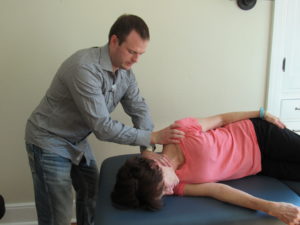
LEVATOR SCAPULA MANUAL STRETCH
NECK PAIN GONE ONCE AND FOR ALL! 9/5/16
Neck pain can be devastating to deal with be it from whiplash, a fall, poor posture, or any other trauma. Rarely does neck pain only encompass the neck, but also the shoulder and upper back. It is not uncommon to have pain deep in the shoulder blade or on the inside top of the shoulder blade that is coming from the neck. Physical therapy is often one of the stops along the road of recovery. Traditional physical therapy is not always able to deal with the complexity of neck pain because just doing the exercises in physical therapy can’t take care of the whole problem. What is often needed is the skill of a manual therapist performing osteopathic manipulation and myofascial release. This is because the muscles and joints of the neck, upper back, and shoulder blades need to be released with manual therapy before exercises with help. The sequence of my manual therapy treatment starts at the lower thoracic spine working up to the upper thoracic spine. Then working on the levator scapula muscles and scalenes of the neck with myofascial release techniques. Finally the cervical spine gets treated out with manipulation. The ribs may also need to be treated. This does not have to be the treatment sequence but this is the pattern I follow. After the manual therapy, a few simple exercises should be given for neck flexibility and to improve posture. Treatments involving manual therapy, and then followed up by simple exercises is a much more effective way to get rid of pain. If you want your pain resolved NOW, then give me a call or book an appointment at wrightphysiotherapy.com. Thank you!
TREATING HIGH SCHOOL ATHLETES FOR IMPROVED PERFORMANCE AND POST GAME HEALING 8/20/16
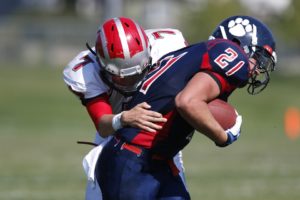
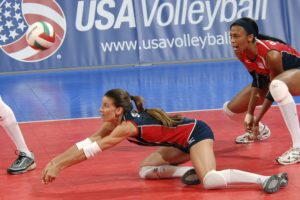
High school athletics are very demanding and can take a toll on the body. A season of wear and tear and injuries leads to underperforming and a less successful season. No athlete wants to underperform especially when the raw talent is present. Performing at the highest level is every athlete’s goal. Most athletes perform conditioning and weight lifting to prepare for and stay strong during the season, but they are missing ONE BIG COMPONANT when it comes to staying healthy. Trainers and conditioning coaches are good at pure strength and endurance exercises but they do not have the education and the ability to evaluate, make assessments, and treat dysfunctions/injuries an athlete may have before and during the season that is limiting the athletes ability to play at the highest level. There is no reason to miss out on the ONE BIG COMPONANT that can lead to a much more successful and healthy season. And what is the ONE BIG COMPONANT? It is having a total body movement evaluation from Wright Physiotherapy to look for problems the athlete may have in muscles and joints that is limiting the highest level of performance. Then the appropriate hands on manual therapy will be performed to correct any dysfunctions that are present. At the end of the session a group of exercises will be given to specifically strengthen the body and deficits that were found. During the season, manual therapy and hands on treatment techniques can be used to heal injuries such as sprains, strains, back pain, knee injury, shoulder injury, hip injury, and injuries of all kinds to keep the player on the field or court throughout the season. Wright Physiotherapy can keep you healthy, so you can be an all-star performer. Give me a call for a healthier and more productive season!
FROZEN SHOULDER/ADHESIVE CAPSULITIS BEING TREATED WITH MANUAL THERAPY 8/6/16
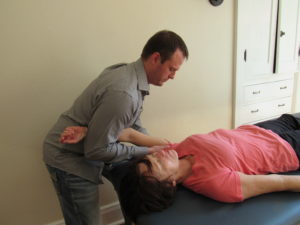
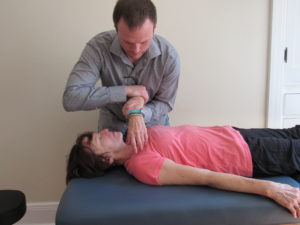
Adhesive capsulitis, most commonly referred to as frozen shoulder (FS), is an idiopathic disease with 2 principal characteristics: pain and contracture of the shoulder joint. It is known as idiopathic because it is a pathology that occurs for unknown reasons. The shoulder pain associated with FS is progressive and is felt mostly when the shoulder is moved close to the end of its range of motion (ROM) where it is stiff. The pain can be caused by certain combined movements of the shoulder, such as abduction and external rotation (eg, grooming one's hair, reaching for a seatbelt overhead) or extension and internal rotation (eg, reaching for a back pocket or bra strap). The pain tends to be constant initially, and then mostly with shoulder use especially at end rom. In approximately 90% of patients with FS, this pain usually lasts 1-2 years before subsiding. The second characteristic of adhesive capsulitis is the adhesion formation of the shoulder joint capsule that restricts the rom of the shoulder. This restriction makes it very hard to move the arm in a full rom. The adhesions “lock” the shoulder joint down and can cause damage to the rotator cuff from abnormal movement over time.
What I see in the clinical setting when someone comes to me with adhesive capsulitis is a very painful shoulder that becomes more painful as it is forced into a stretch. The patient has a hard time lifting the arm overhead and behind the back because of stiffness and pain. As long as the patient does not lift the arm up, it tests out as strong when checking the muscles. The joint has a certain stiffness to it when taking it through passive range of motion. Manual therapy with osteopathic manipulation along with myofascial release techniques are very beneficial in the treatment of frozen shoulder. Using manual therapy can significantly help improve rom and reduce pain when done appropriately, which helps get the shoulder back to its normal function. To improve frozen shoulder in a quick manner, therapy has to include hands on manual techniques with prom and stretching. This is the problem with traditional therapy. Most of the time manual therapy is not performed due to the time restrictions set up by insurance companies. Manual therapy takes time and that is why I am a cash based therapist. I can get you better much quicker not being affiliated with insurance because I can have much longer treatment sessions. So, if you have frozen shoulder or any shoulder pain, call me for an appointment and get pain relief fast.
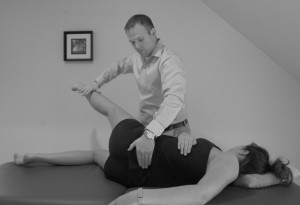
Left on right sacral torsion correction
LEFT ON RIGHT SACRAL TORSION CORRECTION 7/17/16
This is an osteopathic manipulation technique for a sacral dysfunction. More specifically a sacrum that is rotated left on the right oblique axis. This dysfunction can cause intense pain in the low back and/or down the legs. This is one of the problems people often have if they have had therapy or chiropractic care in the past without much help. Unless the dysfunction is corrected, the pelvis and lumbar spine will never move appropriately and pain may never go away. Manual therapy is very helpful in correcting these dysfunctions.
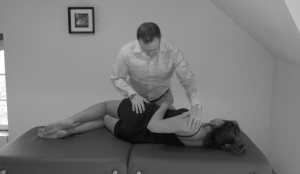
Preparing for Right FRS at L5 correction
RIGHT FLEXED, ROTATED, SIDE BENT L5 (R FRS L5)
When a sacral torsion is present, their is also ALWAYS a dysfunction at the L5 vertebrae. This is due to how the sacrum and lumbar spine interact with each other. The picture shows the set up for the right FRS L5. This has to be corrected out before the torsion is corrected. Again, an easy diagnosis and treatment for someone trained in osteopathic treatment techniques specializing in manual therapy.
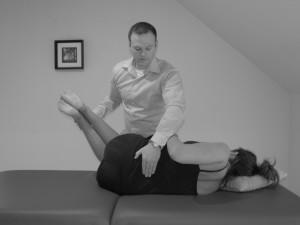
Right ERS dysfunction set up for treatment
RIGHT EXTENDED, ROTATED, SIDE BENT L3 (R ERS L3)
This is another dysfunction that can occur at the lumbar spine. Instead of the spine having an FRS dysfunction, it can also have an ERS dysfunction. These dysfunctions are also easily corrected by manual therapy and can also occur in the presence of a sacral torsion and an FRS in the lumbar spine. When the ERS is at L5 vertebra, their is often a posterior unilateral sacral nutation also present.
WHY MANUAL THERAPY WITH OMT IS IMPORTANT 7/4/16
Medical science has grown by leaps and bounds with the discovery of new drug treatments, surgical procedures, and even improved diagnostic testing. This is all wonderful and has been able to help improve the lives of many patients, but what about patients who do not need surgery and medication is not helpful? It is often forgotten that what some patients really need is a healing touch. OMT (osteopathic manipulation technique) is a hands on manual medicine approach using hands to diagnose, treat and prevent injury. Physical therapists providing OMT will use specialized treatment techniques to stretch muscles, move joint, and relieve pain with gentle pressures. Sometimes OMT can prevent the need for surgery and the use of pain medications. People of all ages and backgrounds can benefit from OMT manual medicine to reduce pain, increase rom, and improve mobility. It works extremely well for patients that have muscle and joint pain also known as musculoskeletal injuries.
Here is an example of how OMT manual therapy can be very helpful. I recently had a gentleman with a shoulder problem. He had a hard time being able to lift his arm up over his head, and it was painful when trying to do so. He was told surgery was his only option. During his first visit I told him not only would I be able to help him but I could do it in 2 visits. I evaluated his shoulder using my hands to touch and feel what was wrong and was able to immediately start treating. His shoulder lacked the normal mobility it should have, which created pinching on his rotator cuff causing pain. I used OMT manual therapy to stretch and normalize his shoulder movement over 2 visits which allowed for complete resolution of symptoms. He now has normal use of his shoulder without pain. Remember, he was told surgery was his only option, and I fixed him in 2 visits that last 1 hour each. That is the power of OMT. Another example is a lady came to me due to having extreme pain in her low back and right hip for 4 years. She works at Walmart and has a physical job. She was sent for therapy and she, luckily, decided to come to Wright Physiotherapy because other therapy had not helped in the past. After examining her I began to treat her low back and hip using, again, OMT manual therapy. She had abnormal rotations in her lumbar spine and sacrum that needed to be corrected out. She came back the next week with almost 100% relief. She said she noticed significant pain reduction the night of the first visit. She came to therapy 3 visits and was ready to be on her own. Wow, complete relief after only 3 visits of physical therapy. It can be amazing! Those are just a couple examples of how manual therapy using OMT can be very helpful and life changing. If therapy has not been helpful in the past then it is time to try Wright Physiotherapy for better results!
BRIEF HISTORY OF MICHIGAN STATE MANUAL MEDICINE 6/5/16
Taken from http://www.com.msu.edu/CME/History.htm
The Michigan State University College of Osteopathic Medicine since its inception has had a mission devoted to undergraduate, post-graduate and continuing medical education.
The first formal continuing education course in manual medicine was held in 1973 for the combined faculties of the Department of Biomechanics and the Department of Family and Community Medicine. Fred L. Mitchell, Sr., D.O., F.A.A.O. provided a five day tutorial on Muscle Energy Technique. The first formal course after Dr. Mitchell died was offered in 1974, again on Muscle Energy Technique, with the faculty of Fred L. Mitchell Jr., D.O., F.A.A.O. and Philip E. Greenman, D.O., F.A.A.O.
The current Manual Medicine Series was the result of a meeting of the North American Academy of Manipulative Medicine in 1977. At that time the organization was limited to MD physicians. John Mennell, M.D. arranged to invite Paul Kimberly, D.O., F.A.A.O. and Philip E. Greenman, D.O., F.A.A.O. to attend the meeting and meet with the board of directors of MAAMM. The objective was to expand the educational offerings for the NAMM membership by including DO physicians as members and faculty, both of which occurred at the meeting. Dr. Mennell felt that Michigan State University would be the best venue for such courses because of both a DO and MD school at the university. While returning from providing a course for German physicians at Grand Canary Island, Drs. Kimberly and Greenman developed the outline for the first Principles of Manual Medicine course that was offered in August 1978 at Michigan State University. The faculty were Philip E Greenman, D.O., Chairman, Paul Kimberly, D.O., Myron Beal, D.O., John Bourdillon, M.D., and John Mennell, M.D. The course was accredited by both the M.D. and D.O. professions.
Additional courses were developed including Muscle Energy Technique Level 1 and 2, High Velocity Low Amplitude Technique, Functional Technique, Craniosacral Technique Level 1 and 2, Exercise Prescription, Extremity Technique, and Myofascial Release Technique. The Principles of Manual Medicine became the prerequisite for the advanced courses.
In 1982 a physical therapist sponsored by an osteopathic physician requested admission to the Principles course and was admitted as a trial. He performed very well and subsequently became a member of the CME teaching staff. Following that course Dr. Mennell said that “we might never educate enough physicians in manual medicine so let us train physiotherapists.” Despite some professional concerns physical therapists were admitted and have successfully attended since.
The Manual Medicine CME series has attracted registrants from throughout the world including Canada, United Kingdom, Germany, Denmark, Finland, Sweden, Brazil, New Zealand, Australia, the Philippines, Japan and South Korea. The series is recognized worldwide as the “Gold Standard” of Manual Medicine continuing medical education.
--Philip E. Greenman, D.O., F.A.A.O.
Michigan State in my opinion has the best manual medicine courses in the world!
PHYSICAL THERAPISTS AND PERSONAL TRAINERS WORKING TOGETHER 5/20/16
Physical therapists are the experts in the field of movement and musculoskeletal injuries. We evaluate, diagnose, make assessments, and treat to get people back to their original level of functioning, but we are not the only skilled profession that is very in tune with how people move and function. Personal trainers are also highly skilled professionals that spend significant time with their clients watching how they move and perform physical activity. They are highly knowledgeable on muscles, how they work, and the kinds of activities to get the muscles strengthened back in shape. Physical therapists and personal trainers should have a symbiotic relationship and not work against each other. It is not a competition. We both want to keep people healthy. I have become a better physical therapist working with personal trainers and athletic trainers over the years. I know my limitations as a physical therapist when it comes to treating patients and getting them back to being as functional as possible. I am very good at making diagnoses when a patient comes to me with an orthopedic injury and I can get them back to a high level of function, but sometimes my skill level will only take the patient so far. For example a patient comes to me with, let’s say, a shoulder or low back injury. I will treat using manual therapy and appropriate exercises to reduce pain and hopefully completely rid the patient of pain, but sometimes I am not able to take the patient to the next level of healing due to the equipment I have at hand. In those situations I rely on personal trainers to use their knowledge and skill to complete the healing process using either more intensive exercises or cross fit training in a gym. Also, physical therapists and personal trainers can be good referral sources for each other. A personal trainer that has been injured can come to me and I can treat them, so they can return to the gym as quick as possible allowing them to work and make money. An injured personal trainer cannot make a living. When this happens trust is built between the personal trainer and myself. The personal trainer learns the healing powers of osteopathic manipulation, and I learn the skill of the personal trainers so I can refer my patients to them for quality training and they can also refer to me with injured clients. A win win situation for both!
FIXING PIRIFORMIS SYNDROME NOT ONLY WITH PHYSICAL THERAPY, BUT MANUAL THERAPY 5/6/16
Have you ever had pain in your rear end, or a tingle down the back of your leg that tends to get worse with pressure on the back of the leg, such as with sitting or even with walking? This can be occurring due to a condition called piriformis syndrome. The piriformis muscle is located in the rear end area and functions to extend, externally rotate, and abduct the hip. It is involved in providing stability to the hip. The sciatic nerve can run underneath or directly through the piriformis and can also be involved if the piriformis muscle becomes dysfunctional.
What can be done to help alleviate the pain from piriformis syndrome? Strengthening and stretching of the piriformis and hip is a typical treatment in physical therapy along with modalities such as electrical stimulation and ultrasound. This may or may not be helpful. What needs to be looked at is WHY the piriformis is dysfunctional. The piriformis becomes dysfunctional due to over use that occurs from abnormal function of the hip and low back. When the glute max and glute medius hip muscles are inhibited and aren’t doing their job because of somatic dysfunction of the low back, the piriformis is one of the muscles that becomes overworked to help stabilize the hip and pelvis. This creates the overuse syndrome of the piriformis, and since the sciatic nerve runs underneath or through the piriformis muscle it can be aggravated causing sciatica down the leg.
Training in osteopathy and manual therapy is imperative to getting proper diagnosis and correction of the pathology. This is due to the spine needs to be looked at for abnormal movement mechanics that causes the glute max and medius muscles to shut down. Explained earlier, when these muscle shut down the piriformis becomes overused, dysfunctional and painful. What will be done at wrightphysiotherapy is the spine dysfunction will be diagnosed and treated using manual therapy. This will let the glute max and medius muscles start working correctly, and then the appropriate exercises will be given to maintain the corrections and to strengthen the system promoting the continued appropriate function of the muscles. When this is done, the piriformis muscle use lessens, letting it relax and calm down. This reduces irritation and the symptoms go away. Unless hands on manual therapy is performed, the body has a very hard time allowing symptom reduction to occur. Manual physical therapy at wrightphysiotherapy is the best option for pain reduction fast!
UNRELENTING KNEE PAIN 4/23/16
Knee pain is very common and can be difficult to treat if the physical therapist is not sure what to look for during the evaluation process. I have found that people with knee pain have some common problems. They have weakness in the hip on the same side of the knee pain along with quad weakness. You also have to be aware of the specific muscle tightness’s that can occur. The rectus femoris, hamstrings and IT band can often times be tight and they need to be appropriately addressed. So far this is pretty easy to figure out, but the evaluation needs to go much deeper. This is why a manual physical therapist is often needed when someone has been unsuccessfully treated for knee pain in the past.
What I would do is start at the lumbar spine and sacrum and work up to the lower thoracic spine looking for any vertebrae that are moving abnormally. When the spine is not moving the way it should, muscles in the body become inhibited and other muscles have an increased tone and will not work appropriately creating an imbalance. If the spine is not addressed, these muscle groups may never function the way they should and the knee pain may never go away. The spinal somatic dysfunctions can be easily corrected by a manual physical therapist. Hip capsular mobility may need to be addressed and then appropriate strengthening exercises and stretches can be given to restore the body’s normal balance, and the pain usually goes away in a short period of time.
Most of the time the spine will never be addressed in the typical insurance based physical therapy setting due to time constraints, therapists not having the appropriate knowledge of the spine, or not even being sure if they are allowed to work on the spine when someone comes in for knee pain. This is why the pain lingers and may never go away. Wright Physiotherapy is a better choice and is why I do not use an insurance based treatment model. Because I am a cash based physical therapist I will treat and fix what needs to be fixed. You will get better quicker and in 2-4 visits the pain will be much improved or gone. If you or anyone you know has knee pain, set up and appointment and I can address it.
ROTATOR CUFF PATHOLOGY 4/12/16
As a physical therapist I see a lot of shoulder pathology. This can be pain anywhere in the general shoulder area, lateral arm, or deep inside the joint. Generically, patients think they have a rotator cuff problem when they have shoulder pain, which it can be, but often times it is much more complicated than that. Let’s say someone has a non-traumatic shoulder pain. Meaning pain is occurring in the shoulder without having any kind of accident or trauma. The question has to be asked, “Why is the pain occurring and what can be causing it?” The shoulder joint needs to be looked at for range of motion (rom) and how it moves. Is it restricted or can it move through a full range? Usually the rom is restricted due to capsular tightness and this needs to be addressed. The rotator cuff muscles tend to be weak. The scapula is usually not moving in a normal upward rotation, and this can be due to inhibited low trap muscle and serratus anterior muscle. Posture is often times poor with a tight pec minor muscle and levator scapulae on the same side that has an increase in tone. All of these issues cause a poor functioning shoulder from abnormal movement mechanics, and leads to pain over time without an accident or trauma.
As a manual physical therapist what would I do that you would not get from going to typical physical therapy? First I would perform osteopathic manipulation of the thoracic spine that is causing the inhibition of the low trap and serratus anterior. Then the increased tone of the pec minor and levator scapulae would be addressed with manipulation and myofascial work. Followed by joint mobilization to specifically stretch the shoulder joint capsule to start to normalize rom. I would then finish off the treatment by giving rotator cuff strengthening, postural strengthening, and at home stretching. Usually 2-4 visits of this will completely resolve the issue over the period of a 4-6 weeks. If you have shoulder pain and would like to be treated quickly and efficiently, please give me a call or email me at my website wrightphysiotherapy.com.
WHAT DO I LOOK FOR WHEN TREATING LOW BACK PAIN? 4/10/16
Low back pain is very common in today’s society. Most people have dealt with low back pain themselves or at least know multiple people with low back pain. It can be very debilitating and life changing, especially if the pain does not go away. Treatment for low back pain in physical therapy is usually mediocre at best due to the difficulty in being able to properly diagnose where the pain is being generated. Pain can come from the discs, nerve roots, facet joints, and abnormal muscle use. Having a good understanding of how the spine moves and functions, and how abnormal spinal movement affects the body is key to successful treatment in physical therapy.
What do I look at when evaluating a low back? I look for specific weakness in the glute max and med muscles. They are very important in lumbar spine and pelvic stability. The hip flexors are often times very tight, therefore specific manual therapy releases have to be performed along with stretching. Transversus abdominal and deep low back muscle called the multifidus also need to be retrained appropriately. I also look at very specific movement of the individual lumbar spine vertebrae, thoracic vertebrae, and sacrum. If the vertebral segments are not moving the way they should, osteopathic manipulation is performed to help correct the movement. I use a lot of osteopathic manipulation (OMT) called muscle energy techniques (MET). Uncorrected vertebrae will cause muscles to shut down and not do their job. This is where the skill of a movement expert and manual therapist comes into play to be able to find and correct the abnormal spine movement or lack of movement. The abnormal spine movement is called a somatic dysfunction which will be discussed in another blog. Using those basic guidelines is how I have been able to be very successful in fixing low back pain be it chronic or acute. Acute low back pain is much easier to fix with usually only needing 1-2 treatments over a 2-4 week period. Chronic low back pain is more difficult to fix but can usually be done over a 6 week period and a total of 4-6 visits. Come give physical therapy at Wright Physiotherapy a try and you will be amazed at your new pain-free way of life! Go to the contact page and send me an email to schedule an appointment or give me a call.